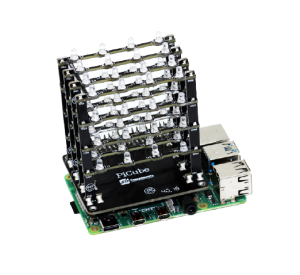Difference between revisions of "PiCube"
From SB-Components Wiki
(→Pinout) |
(→Pinout) |
||
| Line 28: | Line 28: | ||
'''GPIO PIN Number''' | '''GPIO PIN Number''' | ||
<table class="wikitable"> | <table class="wikitable"> | ||
| − | + | <tr><td> '''7(L1)''' </td><td> 11(L2) </td> <td> 35(L3) </td> <td> 37(L4) </td> </tr> | |
<tr><td> Relay 1 </td> <td> 37 </td> <td> GPIO 26 </td></tr> | <tr><td> Relay 1 </td> <td> 37 </td> <td> GPIO 26 </td></tr> | ||
<tr><td> Relay 2 </td> <td> 35 </td> <td> GPIO 19 </td></tr> | <tr><td> Relay 2 </td> <td> 35 </td> <td> GPIO 19 </td></tr> | ||
Revision as of 11:24, 8 November 2021
Pico Cube
PiCube is a 4x4x4 LED cube HAT for Raspberry Pi with 5V DC operating voltage. PiCube, a 64 monochromatic (Red, Blue, Green) LED device, is a fun way to learn programming. It is designed to perform incandescent operations with low energy consumptions, robust outlook, and easy installation that make people/kids/users learn the effects of LED lights with a different pattern of colours via the combination of software and hardware i.e. Raspberry Pi.
Features
- Standard 40 Pins Raspberry Pi Header
- GPIO Based Communication
- 64 High Intensity Monochromatic LED
- Individual LED access
- Each Layer Access
Specifications
- Operating Voltage - 5V
- Colors - Red/Green/Blue
- Communication - GPIO
- LED - 64

Buy it From : Click Here
Pinout
GPIO PIN Number
| 7(L1) | 11(L2) | 35(L3) | 37(L4) |
| Relay 1 | 37 | GPIO 26 | |
| Relay 2 | 35 | GPIO 19 | |
| Relay 3 | 33 | GPIO 13 | |
| Relay 4 | 31 | GPIO 6 | |
| Relay 5 | 29 | GPIO 5 | |
| Relay 6 | 23 | GPIO 11 | |
| Relay 7 | 21 | GPIO 9 | |
| Relay 8 | 19 | GPIO 10 |
Installation
Python
- Stack PiCube on Raspberry Pi 40 Pin GPIO header.
- Open Git Bash Terminal and clone/download the repository by typing the below command in the terminal:
git clone https://github.com/sbcshop/PiCube.git
- Your code will be downloaded to the '/home/pi' directory. Use the 'ls' command to check the list of directories and the 'cd' command to enter the directory.
cd PiCube
- 'demo.py' is an example code for PiCube. Run test file and play with PiCube by running below python command.
python3 demo.py
It will run a different LED pattern on PiCube. You can also modify this code to put your own creativity.
Resources
Github
